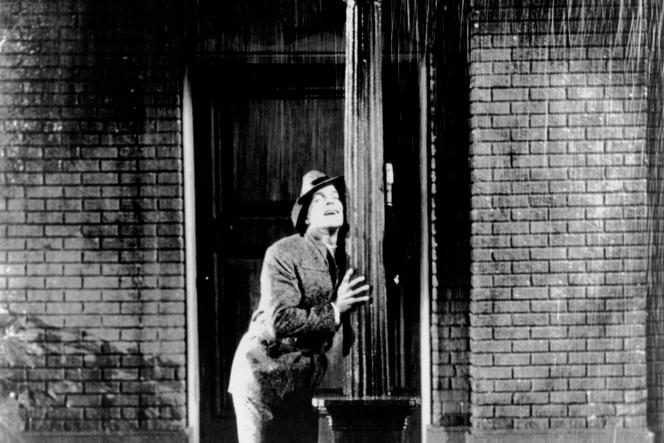


The lion of the Metro-Goldwyn-Mayer film company roars. Seen first from behind in yellow raincoats, then turning toward the camera, Kathy (Debbie Reynolds), Don (Gene Kelly) and Cosmo (Donald O'Connor) intone: "I'm singin' in the rain... Just singin' in the rain." It's a light-hearted entry into Singin' in the Rain (1952), directed by Stanley Donen and Kelly, a musical comedy in sumptuous Technicolor.
A little over an hour later, Don, who has just kissed Kathy on the doorstep of her apartment building, is smiling blissfully. It's raining. He hums "doo-doo-doo-doo, doo-doo-doo-doo-doo," closes his umbrella, and starts to dance. He bursts into Singin' in the Rain, climbing a lamppost, tap-dancing on the sidewalk, in the gutter...
Four minutes of elegance choreographed by Kelly, four minutes of the joy of being in love. While not the film's most impressive, like O'Connor's acrobatics during Make 'Em Laugh and the long tribute to Broadway musicals, including a dance from Kelly with Cyd Charisse, the sequence remains its most famous.
With the exception of Make 'Em Laugh, written and composed especially for the film, Singin' in the Rain and the film's 15 or so other songs all come from musicals of the late 1920s and 1930s, from stage or screen. In most cases, the lyrics were written by Arthur Freed and the music by Nacio Herb Brown. Singin' in the Rain, by Freed and Brown, appears in The Hollywood Revue of 1929, directed by Charles Reisner. It was one of Metro-Goldwyn-Mayer's first sound films.
It has no storyline, just a series of song-and-dance numbers, including Singin' in the Rain sung by Cliff Edwards, who also plays the ukulele. He, too, wears a raincoat – the reference in the credits of Kelly and Donen's film is clear – but he appears in black and white, since it's 1929. Standing still in a corner of the screen, he is joined by a troupe of some 20 dancers. It's amusing, but has far less of the impact and poetry of the 1952 version.
Numerous other renditions followed. Among them are jazz pianist Oscar Peterson's 1958 version, which stepped up the tempo and swing; singer Sammy Davis Jr. with a children's choir in 1974, on a 45 rpm record with a cover featuring a close-up of his face next to the image of Kelly on his lamppost; and a 1977 disco arrangement by singer Sheila.
Then, infamously, there's Stanley Kubrick's use of the song in his film A Clockwork Orange (1971). Alex (Malcolm McDowell) and his gang have broken into a writer's house, armed with canes. The furniture is destroyed, the man is beaten up and Alex rapes his wife. As Alex sings this ode to the joy of love, it is transformed into the chilling refrain of psychopaths.
